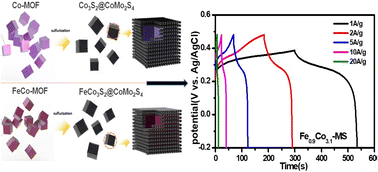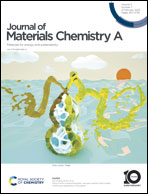Sulphur vacancy induced Co3S4@CoMo2S4 nanocomposites as a functional electrode for high performance supercapacitors†
Abstract
Vacancy engineering offers an attractive approach to improving the surface properties and electronic structure of transition metal nanomaterials. However, simple and cost-effective methods for introducing defects into nanomaterials still face great challenges. Herein, we propose a facile room temperature two-step technique that utilizes Fe as the dopant to enhance S vacancies in cobalt-based metal–organic frameworks (MOFs). The Fe–Co-MOF was converted into a hollow Fe–Co3S4 confined in CoMo2S4 to form Fe–Co3S4@CoMo2S4 nanosheets. The as-prepared material showed enhanced charge storage kinetics and excellent properties as an electrode material for supercapacitors. The obtained nanostructure displayed a high specific capacitance (980.3 F g−1 at 1 A g−1) and excellent cycling stability (capacity retention of 96.5% after 6000 cycles at 10 A g−1). Density functional theory (DFT) calculations show that introducing defects into the nanostructures leads to more electrons appearing near the Fermi level, which is beneficial for electron transfer during electrochemical processes. Thus, this work provides a rational cost-effective strategy for introducing defects into transition metal sulfides and may serve as a potential means to prepare electrode materials for energy storage.



 Please wait while we load your content...
Please wait while we load your content...